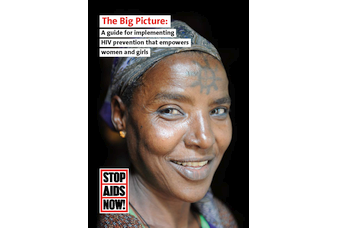The Big Picture: A guide for implementing HIV prevention that empowers women and girls
From 2006 to 2010 STOP AIDS NOW! supported an innovative project in Kenya and Indonesia which gave equal weight to HIV prevention, gender equity and human rights. At the end of the project they asked me to set out the theory and practice of their partners’ efforts in a ‘how to’ guide. This is the result, which I co-authored with the project’s manager, Jennifer Bushee.
This guide will be particularly interesting for people working at community level who want to address the structural factors behind the vulnerability of women and girls to HIV.
Extract
This guide provides ‘how-to’ information for developing a ‘transformative approach’ to HIV prevention for women and girls. Such an approach addresses key root causes of vulnerability to HIV and seeks to reshape the beliefs, attitudes and behaviours of individuals and communities in favour of women and girls and gender equality. It also aims to empower women and girls to protect themselves from HIV infection and from the negative impact of living with HIV.
It sets out the rationale for working on HIV prevention using a transformative approach. It also shares experiences and promising practices from the Gender Development Project. It then provides 5 steps based on these for developing HIV prevention work aimed at reducing the HIV risk of women and girl through promotion of gender equality and women’s rights.
This guide will be particularly interesting for people working at community level who want to address the structural factors behind the vulnerability of women and girls to HIV.
We note that the advice in this guide is not fixed and definite; please read it as providing suggestions based on the experiences of the partners in the Gender Development Project. The advice should be adapted to fit local needs and the relevant social, political and cultural context.
We also note that this guide is not comprehensive and is not written to support the development of a whole project cycle. It gives guidance about how to think from a ‘gender transformative’ perspective, but it does not, for example, give step-by-step instructions for doing a needs assessment.
Finally, we note that this guide encourages readers to think differently about how to respond to HIV, using a holistic perspective, the so-called ‘big picture’. This approach gives you wider scope for doing HIV prevention work. It allows you to integrate HIV prevention in other work on gender and rights. It also allows you to respond more closely to the felt needs of girls and women. Crucially, the ‘big picture’ approach, over time, allows you to work in a ‘transformative’ way. This means it helps supports people to transform or change gender relations in ways that are beneficial to all, including—but by no means limited to—by reducing vulnerability to HIV transmission.




